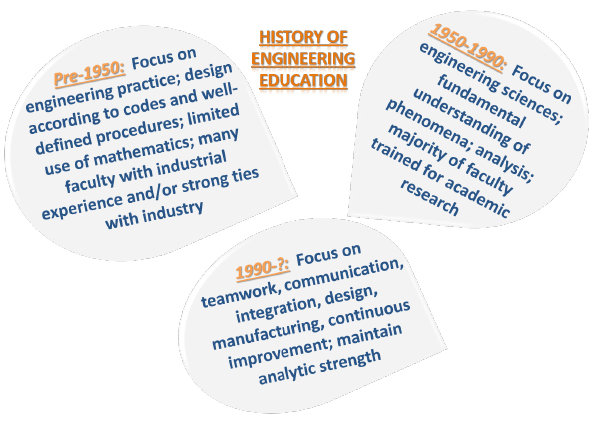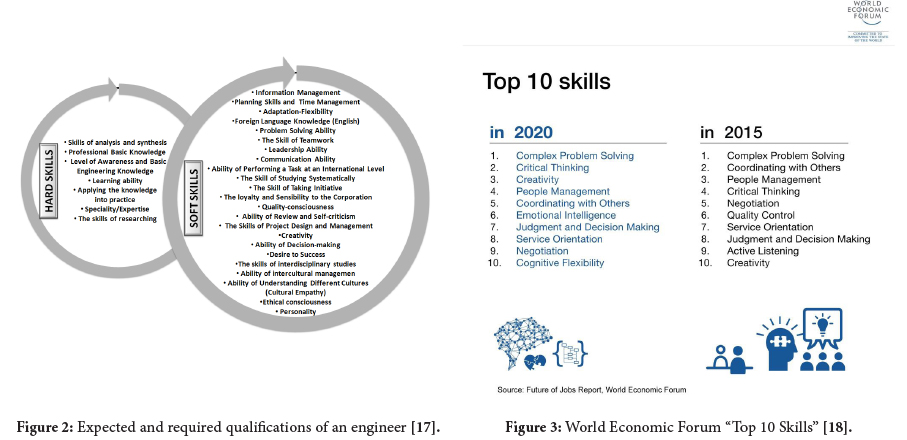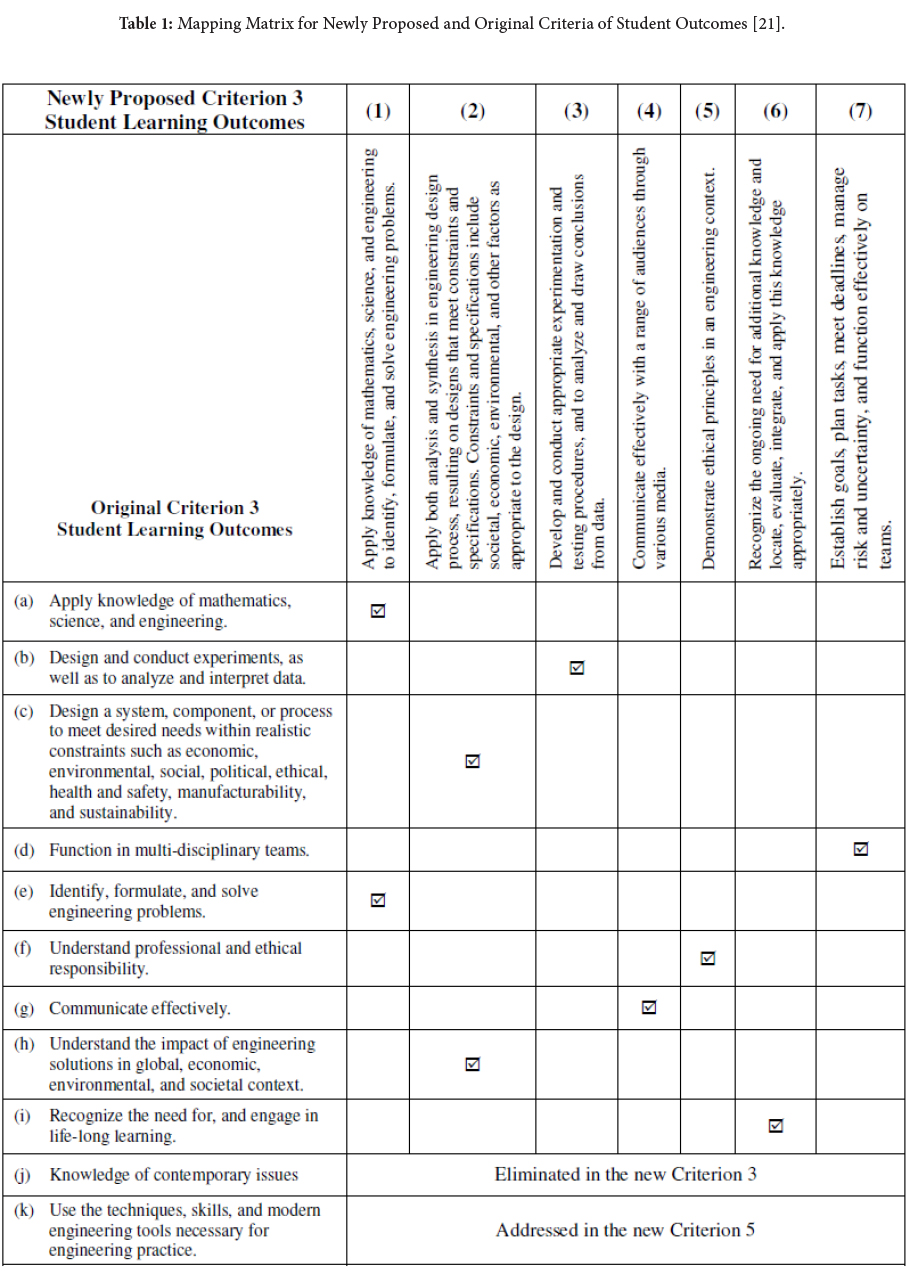Ayşe Kılıça* and Yılmaz Taptıka
aIstanbul Technical University, Chemical and Metallurgical Engineering Faculty,
Department of Metallurgical and Materials Engineering, Istanbul, Turkey
*aypar@itu.edu.tr
INTRODUCTION
Looking at today’s world, although there are many differences among all countries within various subjects, the common ground on where they can meet is education. In the globalized world conditions that enter into the process of change from social, scientific, technological, political and economic aspects; all of the developed or developing countries should be able to provide the requirements and catch the era with being well-equipped with modern knowledge and skills and also being qualified in all fields and professions. The provision of changing conditions can be achieved through integrating different educational methodologies into the education system within the context of both diverse concepts and phenomena (such as; sustainability, life-long learning, problem solving and team-based approaches…etc.) and also new assessment & evaluation instruments and learning and teaching techniques.
Before touching on the issues mentioned above, it would be better to start with a conceptual description and brief history of engineering education.
ENGINEERING EDUCATION
“Engineering Education” concept can be explained dividing it into two parts as “engineering” and “education”. The word “education” is derived from Latin word “educare” which means “to raise, to bring up, to develop” [1]. Mankind has been involved in many educational processes since its first existence. Some examples for the definition of education are listed below:
• “Capacity to feel pleasure and pain at the right moment” (Plato) [2].
• “The creation of a sound mind in a sound body” (Aristotle) [2].
• “The process living through a continuous reconstruction of experiences. Education is not preparation for life; education is life itself” (Dewey) [3-4].
• “The most powerful weapon which you can use to change the world” (Nelson Mandela) [5].
If we have to define education: “a form of learning in which knowledge, skills and habits of a group of people are transferred from one generation to the next through teaching, training or research” [6]. Shortly it is preparing a person to face everyday life.
On the other side, the word “Engineer” is derived from English verb “to engine” and latin word “ingenium” that means “creativity, intelligence and invention” [7]. “Engineering is the field or discipline, practice, profession and art that relates to the development, acquisition and application of technical, scientific and mathematical knowledge about the understanding, design, development, invention, innovation and use of materials, machines, structures, systems and processes for specific purposes” [8].
According to ABET engineering is “the profession in which a knowledge of the mathematical and natural sciences gained by study, experience, and practice is applied with judgment to develop ways to utilize, economically, the materials and forces of nature for the benefit of mankind” [9].
Also NAE (National Academy of Engineers) indicates that “Essence of engineering, the iterative process of designing, predicting performance, building and testing should be taught from the earliest stages of the curriculum, including the first year” [10].
Just to summarize: we can all agree that engineering is everywhere and gives shape to our world. Engineers are creative problem solvers and they design, create or modify nearly everything that we see, hear, touch, eat or wear in our daily lives [11]. They have one common desire as ABET also mentioned, to make the world a better place.
Engineering practice requires multidisciplinary knowledge and the abilities to evaluate, to be creative to learn what is relevant as necessary, and then to be able to apply this knowledge responsibly and efficiently in a specific project [12].
Engineering history is a combination of engineering profession history and technology history that makes up the working area of engineers. Comparing with the history of science, the engineering history has a shorter past and resources that are used to acquire information are limited as the Anglo-Saxon philosophy and the historian-engineer relationship have not been developed [7,13]. Engineering actually has a history based on ancient times. Especially when it is characterized in terms of first engineering applications; examples, remains and findings from Mesopotamia, Ancient Egypt, Greek and Roman regions and periods are the strongest evidences of this [7,14,15].
Generally, it is possible to examine the engineering history under 3 groups as; before 1950s, between 1950-1990s and from 1990s to nowadays.
As the cold war has affected the engineering education deeply and no substantial changes occurred up to 1950, the first period is generally mentioned as pre-1950. Between 1950-1990; change from practice to science phenomena attracts more attention. Late 1980s, also the growing role of computer and software tools becomes important. Industry and university relations become comprehensive. 1990s brought out significant changes in engineering education on design rules. Else, multidisciplinary education, student-centered learning importance grow. Relationship with industry show accelerated growth and development in many aspects: patent, know-how, venture capital companies for innovation and entrepreneur. Shortly globalization occurs after 1990s in education [16] (Figure 1).

REQUIREMENT OF REFORM IN ENGINEERING EDUCATION: 21st CENTURY ENGINEERS
So if we look at today, why do we need to transform education? Or why should we make a reform in education? The world is changing and also frontiers and synergies (energy, environment, health, manufacturing, logistics, communication...etc.) are changing, too. As the engineers help shape the future, our students should be ready to needs and requirements of the industry and overcome various challenges such as [16]:
• Global competition criteria “focus on time-to-market, cost, quality, customer orientation” are major drivers for engineering employment
• Intelligent Technologies enable to “work smarter, be much more creative” that makes revolution in learning process.
• Changing working environment conditions needs developing “interpersonal skills”
• Classical economic balance are mostly affected from “massively integrated populations, health, safety, zero discharge, life-cycle costs, environmental issues, social and political concerns”
According to the employers’ perceptions of weakness in today’s new engineering graduates is that entry level engineers lack necessary skills and the business environment changed a lot but education did not keep the pace. The university education should now shape itself in a technology-based manner in the direction of market demands and it needs to enter into a change with the aim of training their students with a different perspective. One of the major and initial step is to redesign the curriculum so students can graduate with attaining the soft and hard skills that are expected and required in the professional working life (Figure 2) [17].

Today’s engineering graduates should be global engineers. Recently, World Economic Forum announced “Top 10 Skills” that graduates should attain for the future jobs and also gives a comparison of years 2015 and 2020 between each other (Figure 3) [18].
In parallel with all of the issues mentioned above, a set of standards namely, the Engineering Criteria 2000 (EC2000), is adopted by ABET (Accreditation Board for Engineering and Technology), altered the keynote of engineering accreditation. As outcome-based assessment provides convenience in the process of continuous improvement, outputs (what is learnt) become much more prominent than inputs (what is taught). In the content of EC2000, 11 student outcomes (a-k) are identified that should be acquired by graduate students [19]:
(a) an ability to apply knowledge of mathematics, science, and engineering
(b) an ability to design and conduct experiments, as well as to analyze and interpret data
(c) an ability to design a system, component, or process to meet desired needs
(d) an ability to function on multi-disciplinary teams
(e) an ability to identify, formulate, and solve engineering problems
(f) an understanding of professional and ethical responsibility
(g) an ability to communicate effectively
(h) the broad education necessary to understand the impact of engineering solutions in a global and societal context
(i) a recognition of the need for, and an ability to engage in life-long learning
(j) a knowledge of contemporary issues
(k) an ability to use the techniques, skills, and modern engineering tools necessary for engineering practice.
Upon the announcement made by ABET, some important changes are made to Accreditation Criteria and approved for implementation in the 2019-2020 cycle. Newly applicants can prepare themselves to both old and new criteria up to year 2020. However, by the beginning of year 2020, the newly approved criteria will be mandatory for all programs in the 2019 – 2020 accreditation cycle [20].
One of most important change has occurred in “Student Outcomes” Section. Differently from above mentioned 11 Student Outcomes (a-k), there will be 7 SOs that should be attained by the programs’ graduates [20]:
(1) an ability to identify, formulate, and solve complex engineering problems by applying principles of engineering, science, and mathematics
(2) an ability to apply engineering design to produce solutions that meet specified needs with consideration of public health, safety, and welfare, as well as global, cultural, social, environmental, and economic factors
(3) an ability to communicate effectively with a range of audiences
(4) an ability to recognize ethical and professional responsibilities in engineering situations and make informed judgments, which must consider the impact of engineering solutions in global, economic, environmental, and societal contexts
(5) an ability to function effectively on a team whose members together provide leadership, create a collaborative and inclusive environment, establish goals, plan tasks, and meet objectives
(6) an ability to develop and conduct appropriate experimentation, analyze and interpret data, and use engineering judgment to draw conclusions
(7) an ability to acquire and apply new knowledge as needed, using appropriate learning strategies.
Also Mapping Matrix summarizes the differences between the newly proposed criteria and the original one (11 SOs: a-k) (Table 1) [21].

As a conclusion, new world needs the engineers to be trained and graduated with all skills mentioned above. In this regard, it has become compulsory for the education system to enter into a rapid and radical change from different perspectives with providing cooperative & collaborative working environments with all stakeholders.
REFERENCES
1. Türer, A. (2011). Türk Eğitim Tarihi: 1. Baskı, Ankara: Detay Yayıncılık.
2. Sakaoğlu, N., Osmanlı Eğitim Tarihi, İletişim Yayınları, 1991, İstanbul
3. Dewey, John. Deneyim ve Eğitim (Çeviren: Sinan Akıllı), ODTÜ Yayıncılık, 1. Baskı, 2007, Ankara.
4. Dewey, John. Demokrasi ve Eğitim (Türkçesi: M. Salih Otaran), Başarı Yayımcılık, 1996, İstanbul.
5. Washington Post, Nelson Mandela on the Power of Education, December 5, 2013, by Valerie Strauss.https://www.washingtonpost.com/news/answer-sheet/wp/2013/12/05/nelson-mandelas-famous-quote-on-education/?utm_term=.ca24c62768e4
6. Jared Keengwe, 2015. Promoting Active Learning through the Integration of Mobile and Ubiquitous Technologies, IGI Global, USA.
7. Durmuş Günay, Mühendislik, Teknoloji ve Tarih, Mimar ve Mühendis Dergisi, Sayı:30, Sayfa:6-14.
8. Engineering: Issues, Challenges and Opportunities for Development, Unesco Report, Unesco Publishing, 2010.
9. ABET Engineering Definition, http://users.ece.utexas.edu/~holmes/Teaching/EE302/Slides/UnitOne/sld002.htm
10. National Academy of Engineering, Changing the Conversation: Messages for Improving Public Understanding of Engineering, National Academies Press, 2008, ISBN:978-0-309-11934-4.
11. ASEE, 2004. The Top 10 Benefits of an Engineering Career. Retrieved December, 20, 2017, from http://engineeringk12.org/
12. Ivan SIMAN, 2013. Innovations in Engineering Education, Engineering Academy of the Czech Republic. http://www.eacr.cz/miranda2/m2/dokumenty/Innovations-in-Engineering-Education.pptx Retrieved 29.12.2017.
13. Antoine Picon, 2004, Engineers and Engineering History, History and Technology, 20 (4), 421-436.
14. Richard Shelton Kirby, Sidney Withington, Arthur Burr Darling, Frederick Gridley Kilgour, Engineering in History, 1956, McGraw-Hill Company, Newyork, A.B.D.
15. Bir Mühendisin Dünyası, James L. Adams, 2002, Tübitak Popüler Bilim Kitapları 13, 12. Basım, Ankara.
16. Educating Engineers for the 21st Century: The Role of Engineering Education and Accreditation,2016. Prof. Dr. John W. Prados, The University of Tennessee.
17. Ayşe Kılıç, Yılmaz Taptık, 2012. “Metallurgical and Materials Engineering Education:Current Techological Development, Requirements and New Approaches, 16. Uluslararası Metalurji ve Malzeme Kongresi, 13-15 Eylül, İstanbul.
18. The Future of Jobs, 2016. World Economic Forum Report. https://www.weforum.org/reports/the-future-of-jobs
19. ABET, Inc. Criteria for Accrediting Engineering Programs. (2016). http://www.abet.org/accreditation/accreditation-criteria/criteria-for-accrediting-engineering-programs-2016-2017/ Retrieved 29.12.2017.
20. ABET Accreditation Changes, Retrieved 29.12.2017. http://www.abet.org/accreditation/accreditation-criteria/accreditation-alerts/
21. Rami J. Haddad, Youakim Kalaani, Adel El Shahat, 2016. An Optimal Mapping Framework for ABET Criteria 3 (a-k) Student Outcomes into the Newly Proposed (1-7) Student Outcomes, Proceedings of the 2016 IAJC-ISAM Joint International Conference.
22. J. E. Mills and D. F. Treagust, Australasian J. of Engng. Educ., online publication 2003-04. http://www.aaee.com.au/journal/2003/mills_treagust03.pdf


